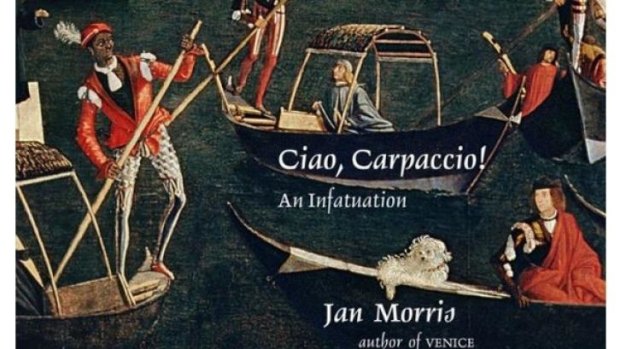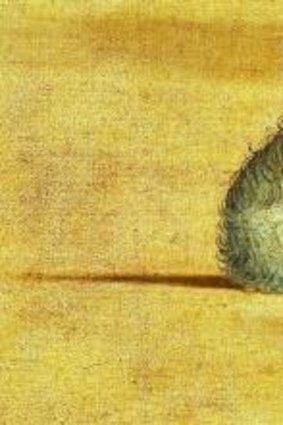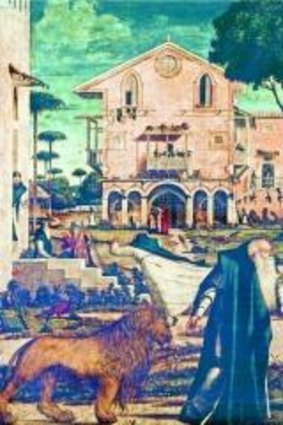By Desmond O'Grady
Ciao, Carpaccio!
Jan Morris

Ciao, Carpaccio! by Jan Morris
Pallas Athene, $39.95
Review by Desmond O'Grady

Detail from The Vision of St Augustine by Vittore Carpaccio.
After I'd been to Modern Art Biennales in Venice I always went to the nearby church of San Giorgio degli Schiavoni (St George of the Slavs) to refresh my eyes with Vittore Carpaccio's cycle of paintings. Their intricate light-filled scenes in rich colour were a tonic after the wilder shores of ugliness at the Biennale.
My favorite detail was the small seated rough-haired white dog, which seems vibrant with a desire to go for a walk with its master, in The Vision of St Augustine. He is also a favourite of Jan Morris, but she loves most things about Carpaccio, which is why this brief, profusely illustrated, long, narrow little book, announced as her last, is subtitled: An Infatuation.
She also calls it a "self-indulgent caprice"; but while it can seem as rambling and whimsical as a fireside chat, it is steeped in the knowledge garnered when she lived in the city for years working on her masterly Venice. Her comment on Carpaccio's horses is illuminated by her awareness that horses were rare in his Venice, and the same knowingness enriches her comments on his wide variety of headgear and the myriad types of his ships. He was a dab hand at elaborate buildings too, and she adds that he painted a dome similar to that of the Salute church before it was even built.
She regrets that nowadays 'carpaccio' is associated more with sliced raw beef and mustard, a dish invented in Venice in 1970, than with a Renaissance painter (circa 1465-1525) and wants to redress the balance.

St Jerome Leading His Lion into the Monastery, from the book Ciao, Carpaccio! by Jan MorrisCredit: Vittore Carpaccio
At first glance his paintings, most of which are still in the Venetian confraternity buildings where he painted them, can look like illustrations for a children's book. They are striking tableaux that mix aspects of Venetian life with biblical and historical scenes. Their sharply-focused details add credibility to episodes with a playful naïf or fantasy element. Some are enigmatic and some documentary, such as that of an early form, otherwise undocumented, of the Rialto as a wooden drawbridge. Strange gondolas abound.
"It is another world that Carpaccio is creating," Morris says, "reality of another kind", as in her beloved Welsh Mabinogion tales and the magic realism of today.
Carpaccio relishes pageantry, ships of all shapes, musical instruments, animals: his paintings contain a menagerie of birds, dogs, lions (the emblem of St Mark and of his city), monkeys, lizards, rabbits, hyenas, dragons, unicorns, basilisks, all full of life.
The gusto and refinement of his paintings combine with a gentle humour, in individual figures, and in scenes such as that of St Jerome entering his monastery in Bethlehem with his tame lion at his heel and monks fleeing in all directions. All the reproductions – details and whole paintings correlated with the text – contrive to be both bright and delicate. However, in this scene she calls the monks' habits black and white when they're in shades of dark blue and white. Or was it a trick of the light the photos were taken in?
Carpaccio had a wife, Laura, and two sons who were mediocre painters. But not much is known of his life, so Morris can speculate. As he aged he lacked commissions; new styles were making him look old-fashioned. He was a judge in examinations on two young artists who would surpass him: Titian and Giorgione. Morris doesn't exaggerate his merits. It's enough that she pays this warm-hearted tribute to him and his works and makes us see them afresh. This is a collector's item.